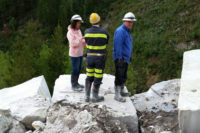Obviously, there’s no one-size-fits-all answer to this question, but I can tell you that a number of the fabricators I have visited in recent months have pointed to investments in stoneworking technology as beneficial in weathering the financial crisis. Two of them can be found in this issue of Stone World.
Our first “Fabricator Case Study” in this issue highlights PMP Marble & Granite of Troy, MI. When we first covered this company back in 2005, it was clear that owner Harry Partalis believes in investing in state-of-the-art technology, and this has continued since then, as the company has added a range of new equipment. This includes big-ticket items such as a CNC bridge saw, a bridge polisher and a second waterjet. “The waterjets helped keep us busy when things were really bad,” Partalis explained. “In 2009, the residential work actually kept us going. The very high-end market was still strong, so we did not even drop 5% in sales. Price is also less of an issue with that market.”
Our second “Fabricator Case Study” in this issue focuses on La Pietra in Brookfield, CT, and it has taken its use of CNC technology beyond countertops into a whole new revenue stream. “We decided to go with the 5-axis machine in order to explore new products like carved soapstone sinks,” explained owner Fabio Figueiredo. “We ship our soapstone sinks nationwide to other fabricators. We have even produced a sink for a customer in France.”
On another note, I recently conducted a roundtable with members of the Stone Fabricators Alliance on how technology investments have affected their business, and they offered some candid thoughts. The full roundtable is published later in this issue, but here are some highlights.
On electronic scheduling software: “I don’t know how I’d run my business without it.”
On digital templating: “We have been using [digital templating technology] for the last five-plus years and will not ever go back to ‘stick’ templates.”
On advanced equipment: “On our manual saw, it would take us about 1 1/2 to 2 hours to accurately cut a slab. Now with the CNC saw, that time has gone to about 15 minutes per slab. The CNC router will accurately finish off all the edge work, sink cutouts, etc. so that there is minimal hand work to finish off the parts. The entire process has helped us create a more accurate, better quality countertop in less time, which means less cost to the consumer.”
On an all-digital shop: “Becoming digital has increased our production capacity without having to add people.”
On the learning curve: “When we purchased the first CNC, I had no experience with anything digital. But I personally went for training. We were producing on the machine effectively within a month. Now almost everyone in the shop is digitally capable.”
On employee acceptance of new technology: “I asked a few of the shop guys if they could ever go back to non-digital fabrication, they all said they would quit.”
Now, not everyone is ready to go out and purchase advanced technology. (A still-active industry poll at www.stoneworld.com certainly shows some hesitation, and we welcome your participation in this poll as well.) But for those who have made the investments, it is promising to see that it is helping their business as opposed to dragging them under.



